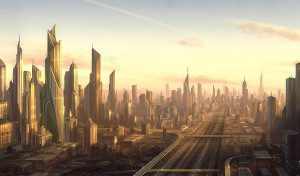Film Review: ‘City Visions’ #4
 Martin Earnshaw | 9 October 2014
Martin Earnshaw | 9 October 2014
Ecumenopolis: City without Limits, Dir. Imre Azem, 2012
When we think of a World City we think of a globalised hub like London where people from all over the world come to live, work or study. An Ecumenopolis gives the concept of the World City a differentmeaning. Although the term was coined in the 1960’s as an extrapolation of the rapid growth of cities, the idea of a city expanding to cover an entire planet is a far older staple of the science fiction genre.
Imre Azem’s 2011 film Ecumenopolis does give a nod to the sci-fi connotations of its title. It opens with a frenetic animation charting the growth of Istanbul from Ottoman Imperial Capital to modern-day megacity in which we see Matrix style robots (depicting unaccountable capitalists and politicians) moving people and property around the city as they shape the landscape to their whims. The animation ends with the city expanding to cover the whole of Turkey. Most of the film, though, concerns itself with the real-world concern that Istanbul is growing too quickly and chaotically. Istanbul’s recent growth has been impressive: it now has over 14 million inhabitants making it the largest city in Europe.
Azem asks whether this growth is at too high a cost. Istanbul wants to become a world city and has opened up to foreign investors. The docufilm argues that this has been done with scant regard for the environment or the wishes of ordinary people. The emotional heart of the film is the plight of several families of slum dwellers who are shunted round the city like refugees. As the bulldozers destroy their dwellings one man declares “I will rebuild this right now”, and one cannot fail to be moved by their plight as he takes a hammer and nails and tries to knock together the wreckage of his former home.
The refugees manage to publicise their plight and embarrass the city authorities into guaranteeing them alternative housing. As we follow the evictees through the film, they get their housing, ugly modernist tower blocks, but it becomes apparent that they are going to be charged unaffordable rents. Eventually most of them end up moving back to the shanty towns.
Overlaid over this micro narrative is a broader one about Istanbul’s “unsustainable” growth. Azem depicts a city that is being killed by its own growth. The development of Istanbul’s third bridge over the Bosphorus, now called the Yavus Sultan Selim Bridge, is a particular focus. The third bridge is intended to relieve Istanbul’s considerable traffic problems, but the talking heads we see in the film argue that it would concrete over the city’s remaining green spaces, encouraging more building and pushing up property prices.
The film places great emphasis on the need for accountability and argues for a holistic approach to developing the city. This approach, however, conflates the very separate issues of social justice and environmental degradation. The film ends with some of the evictees among the protesters against the third bridge. The connection with the 2013 Turkish Gezi Protests, which contested the urban development plan for the Taksim Gezi Park, is apparent.
In both cases an urban development project acted as a lightning rod for all kinds of discontent, from the poor displaced by building projects to environmentalists protesting against development more widely to an array of minority groups with different agendas. However if one separates the refugee’s problems from environmental concerns, it is clear that the solution to the problems of the former – that of displacement to higher priced housing – is actually quite straightforward; say, subsidising their housing or improving wages. Indeed slowing the development of the city will not help achieve either. Similarly, the underdeveloped metro system and the poor quality of most of Istanbul’s buildings are separate from the issue of how big the city is. Turkey’s growth has hit the buffers recently due to an over-reliance on foreign capital. But while Turkey does need to consult and invest in its people more than it currently does, it will also need ambitious building projects to improve city life. While it was not the film-makers intention, it was quite inspiring, from a Western perspective, to see clips of Turkey’s politicians pushing forward bridges and metro tunnels that will transform the city.
If the world is to become more and more urbanised this century perhaps we should see the concept of an Ecumenopolis not as a potential dystopia but as something that can inspire us to make it work.
Ecumenopolis: City without Limits is part of the series City Visions at the Barbican September / October 2014
Martin Earnshaw is the Chair of the Future Cities Project Readers Group.






